Natural Fractures in Carbonate Basement Reservoirs of the Jizhong Sub-Basin, Bohai Bay Basin, China: Key Aspects Favoring Oil Production
Abstract
:1. Introduction
2. Geological Setting
2.1. Location and Structure
2.2. Stratigraphy
2.3. Reservoir
3. Dataset and Methodology
4. Results
4.1. Fracture Characteristics
4.1.1. Tectonic Fractures
4.1.2. Pressure-Solution Fractures
4.1.3. Dissolution Fractures
4.2. Factors Influencing Fracture Development
4.2.1. Lithology
4.2.2. Mechanical Stratigraphy
4.2.3. Fault
5. Discussion
6. Conclusions
Author Contributions
Funding
Acknowledgments
Conflicts of Interest
References
- P’an, C.H. Petroleum in basement rocks. AAPG Bull. 1982, 66, 1597–1643. [Google Scholar]
- Petford, N.; McCaffery, K.J.W. Hydrocarbons in Crystalline Rocks: An introduction. Geol. Soc. Lond. Spec. Publ. 2003, 214, 1–5. [Google Scholar] [CrossRef] [Green Version]
- Sircar, A. Hydrocarbon production from fractured basement formations. Curr. Sci. 2004, 87, 147–151. [Google Scholar]
- Luo, J.; Morad, S.; Liang, Z.; Zhu, Y. Controls on the quality of Archean metamorphic and Jurassic volcanic reservoir rocks from the Xinglongtai buried hill, western depression of Liaohe basin, China. AAPG Bull. 2005, 89, 1319–1346. [Google Scholar] [CrossRef]
- Price, L.C. Thermal stability of hydrocarbons in nature: Limits, evidence, characteristics, and possible controls. Geochem. Cosmochem. Acta 1993, 57, 3261–3280. [Google Scholar] [CrossRef]
- Gao, X.; Pang, X.; Li, X.; Chen, Z.; Shan, J.; Liu, F.; Zou, Z.; Li, W. Complex petroleum accumulating process and accumulation series in the buried-hill trend in the rift basin: An example of Xinglongtai structure trend, Liaohe subbasin. Sci. China Ser. D Earth Sci. 2008, 51, 108–116. [Google Scholar] [CrossRef]
- Jin, Q.; Zhao, X.; Jin, F.; Ma, P.; Wang, Q.; Wang, J. Generation and accumulation of hydrocarbons in a deep “buried hill” structure in the baxian depression, bohai bay basin, eastern China. J. Pet. Geol. 2014, 37, 391–404. [Google Scholar]
- Schubert, F.; Diamond, L.W.; Tóth, T.M. Fluid-inclusion evidence of petroleum migration through a buried metamorphic dome in the Pannonian Basin, Hungary. Chem. Geol. 2007, 244, 357–381. [Google Scholar] [CrossRef]
- Zhao, X.; Jin, F.; Wang, Q.; Bai, G. Buried-hill play, Jizhong subbasin, Bohai Bay basin: A review and future prospectivity. AAPG Bull. 2015, 99, 1–26. [Google Scholar] [CrossRef] [Green Version]
- Wang, Q.; Laubach, S.E.; Gale, J.; Ramos, M.J. Quantified fracture (joint) clustering in Archean basement, Wyoming: Application of Normalized Correlation Count method. Pet. Geosci. 2019, 25, 415–428. [Google Scholar] [CrossRef]
- Trice, R. Basement exploration, West of Shetlands: Progress in opening a new play on the UKCS. Geol. Soc. Lond. Spec. Publ. 2014, 397, 81–105. [Google Scholar] [CrossRef]
- Parnell, J.; Baba, M.; Bowden, S.; Muirhead, D. Subsurface biodegradation of crude oil in a fractured basement reservoir, Shropshire, UK. J. Geol. Soc. 2017, 174, 655–666. [Google Scholar] [CrossRef]
- Cuong, T.X.; Warren, J.K. Bach Ho field, a fractured granitic basement reservoir, Cuu Long basin, offshore Se Vietnam: A “Buried-hill” play. J. Pet. Geol. 2009, 32, 129–156. [Google Scholar] [CrossRef]
- Jin, Q.; Mao, J.; Du, Y.; Huang, X. Fracture filling mechanisms in the carbonate buried-hill of Futai Oilfield in Bohai Bay Basin, East China. Pet. Explor. Dev. 2015, 42, 497–506. [Google Scholar] [CrossRef]
- Zang, M.; Wu, K.; Cui, Y.; Du, W. Types of buried hill and its hydrocarbon accumulation in Jizhong Depression. J. Oil Gas Technol. 2009, 31, 166–169. [Google Scholar]
- Deng, J.; Shi, H.; Wang, B.; Wang, G.; Chen, G. Characteristics and main controlling factors of Paleozoic carbonate buried-hill gas reservoirs in Bozhong Sag. Pet. Geol. Oilfield Dev. Daqing 2015, 34, 15–20. [Google Scholar]
- Kosa, E.; Hunt, D.W. Heterogeneity in Fill and Properties of Karst-Modified Syndepositional Faults and Fractures: Upper Permian Capitan Platform, New Mexico, U.S.A. J. Sediment. Res. 2006, 76, 131–151. [Google Scholar] [CrossRef]
- Wang, J.; Zhao, L.; Zhang, X.; Yang, Z.; Cao, H.; Chen, L.; Shan, F.; Liu, M. Buried hill karst reservoirs and their controls on productivity. Pet. Explor. Dev. 2015, 42, 852–860. [Google Scholar] [CrossRef]
- Liu, N.; Qiu, N.; Chang, J.; Shen, F.; Wu, H. Hydrocarbon migration and accumulation of the Suqiao buried-hill zone in Wen’an Slope, Jizhong Subbasin, Bohai Bay Basin, China. Mar. Pet. Geol. 2017, 86, 512–525. [Google Scholar] [CrossRef]
- Eig, K.; Bergh, S.G. Late Cretaceous-Cenozoic fracturing in Lofoten, North Norway: Tectonic significance, fracture mechanisms and controlling factors. Tectonophysics 2011, 499, 190–205. [Google Scholar] [CrossRef]
- Joudaki, M.; Farzipour-Saein, A.; Nilfouroushan, F. Kinematics and surface fracture pattern of the Anaran basement fault zone in NW of the Zagros fold-thrust belt. Int. J. Earth. Sci. 2016, 105, 869–883. [Google Scholar] [CrossRef]
- Gong, L.; Fu, X.; Gao, S.; Zhao, P.; Luo, Q.; Zeng, L.; Yue, W.; Zhang, B.; Liu, B. Characterization and prediction of complex natural fractures in the tight conglomerate reservoirs: A fractal method. Energies 2018, 11, 2311. [Google Scholar] [CrossRef] [Green Version]
- Loza Espejel, R.; Alves, T.M.; Blenkinsop, T.G. Distribution and growth styles of isolated carbonate platforms as a function of fault propagation. Mar. Pet. Geol. 2019, 107, 484–507. [Google Scholar] [CrossRef]
- Ding, W.; Zhu, D.; Cai, J.; Gong, M.; Chen, F. Analysis of the developmental characteristics and major regulating factors of fractures in marine-continental transitional shale-gas reservoirs: A case study of the Carboniferous-Permian strata in the southeastern Ordos Basin, central China. Mar. Pet. Geol. 2013, 45, 121–133. [Google Scholar] [CrossRef]
- Nabawy, B.S. Estimating porosity and permeability using Digital Image Analysis (DIA) technique for highly porous sandstones. Arab. J. Geosci. 2014, 7, 889–898. [Google Scholar] [CrossRef]
- Guo, P.; Lei, L.; Ren, D. Simulation of three-dimensional tectonic stress fields and quantitative prediction of tectonic fracture within the Damintun Depression, Liaohe Basin, northeast China. J. Struct. Geol. 2016, 86, 211–223. [Google Scholar] [CrossRef]
- Milad, B.; Slatt, R. Impact of lithofacies variations and structural changes on natural fracture distributions. Interpretation 2018, 6, T873–T887. [Google Scholar] [CrossRef]
- Milad, B.; Ghosh, S.; Slatt, R.; Marfurt, K.; Fahes, M. Practical aspects of upscaling geocellular geological models for reservoir fluid flow simulations: A case study in integrating geology, geophysics, and petroleum engineering multiscale data from the Hunton Group. Energies 2020, 13, 1604. [Google Scholar] [CrossRef] [Green Version]
- Gao, C.; Zhang, X.; Zha, M.; Wang, X. Characteristics of buried hill reservoir in Jizhong Depression. Lithol. Reserv. 2011, 23, 6–12. [Google Scholar]
- Ju, W.; Wu, C.F.; Wang, K.; Sun, W.F.; Li, C.; Chang, X.X. Prediction of tectonic fractures in low permeability sandstone reservoirs: A case study of the Es-3(m) reservoir in the Block Shishen 100 and adjacent regions, Dongying Depression. J. Pet. Sci. Eng. 2017, 156, 884–895. [Google Scholar] [CrossRef]
- Zhao, L.; Jiang, Y.; Liu, H.; Fan, B. Thermal evolution of Paleogene source rocks and relationship with reservoir distribution in Raoyang Sag, Bohai Bay Basin. Pet. Geol. Recover. Effic. 2012, 19, 1–4. [Google Scholar]
- Wu, X.; Niu, J.; Wu, F.; Liu, X. Major control factors of hydrocarbon accumulation in Ordovician interior buried hills, Bohaiwan Basin. Mar. Orig. Pet. Geol. 2013, 18, 1–12. [Google Scholar]
- Yang, M.; Liu, C.; Yang, B.; Zhao, H. Extensional structures of the Paleogene in the central Hebei Basin, China. Geol. Rev. 2002, 48, 58–67. [Google Scholar]
- Su, L.; Luo, P.; Zou, H.; Shi, B.; Zheng, X. Hydrocarbon accumulation conditions of the Ordovician buried hills in the slope zone of the Jizhong Depression. Geotecton. Metallog. 2003, 27, 191–196. [Google Scholar]
- Chang, J.; Qiu, N.; Zhao, X.; Xu, W.; Xu, Q.; Jin, F.; Han, C.; Ma, X.; Dong, X.; Liang, X. Present-day geothermal regime of the Jizhong Depression in Bohai Bay Basin, East China. Chin. J. Geophys. 2016, 59, 1003–1016. [Google Scholar]
- He, D.F.; Cui, Y.Q.; Zhang, Y.Y.; Shan, S.Q.; Xiao, Y.; Zhang, C.B.; Zhou, C.A.; Gao, Y. Structural genetic types of paleoburied hill in Jizhong depression, Bohai Bay Basin. Acta Petrol. Sin. 2017, 33, 1338–1356. [Google Scholar]
- Wu, X.; Lv, Y.; Tian, J.; Guo, Y. Characteristics and evaluation of carbonate buried hill inner cap rock in Jizhong Depression. Lithol. Reserv. 2011, 23, 49–54. [Google Scholar]
- Zhang, W.; Yang, D.; Chen, Y.; Qian, Z.; Zhang, C.; Liu, H. Sedimentary Structural Characteristics and Hydrocarbon Distributed Rules of Jizhong Depression. Acta Geol. Sin. 2008, 82, 1103–1112. [Google Scholar]
- Xiao, Y.; Liu, G.; Han, C.; Zhu, J.; Zhou, C.; Lv, W.; Gao, Y.; Zeng, L.; Ma, X. Development characteristics and main controlling factors of natural fractures in deep carbonate reservoirs in the Jizhong Depression. Nat. Gas Ind. 2018, 38, 33–42. [Google Scholar]
- Du, J.; Zou, W.; Fei, B.; Lei, H.; Zhang, F.; Zhang, Y. Buried Hill Oil and Gas Complex Zone in Jizhong Sub-Basin; Petroleum Industry Press: Beijing, China, 2002. [Google Scholar]
- Yang, K.; Dang, C.; Dai, F. Paleo-source/paleo-reservoir typed reservoirs: Cases of anticlinal paleo-reservoir and buried hill reservoirs in Bohaiwan Basin region. Mar. Orig. Pet. Geol. 2007, 12, 27–32. [Google Scholar]
- Gao, X.; Wu, W.; Lu, X.; Cui, Z.; Kong, L.; Jia, L.; Wang, H. Multiplicity of hydrocarbon reservoir and accumulation controlling factors within buried hills in Jizhong depression. J. China Univ. Pet. 2011, 35, 31–35. [Google Scholar]
- Yu, H.; Wang, D.; Niu, C.; Li, L. Characteristics and formation mechanisms of buried hill carbonate reservoirs in Bonan Low Uplift, Bohai Bay. Pet. Geol. Exp. 2015, 37, 150–156. [Google Scholar]
- Chen, Q.; Lao, H.; Wu, K.; Wu, Z.; Cui, Y. Favorable hydrocarbon accumulation conditions for carbonate reservoirs in deep-buried hills in the Jizhong Depression, Bohai Bay Basin. Nat. Gas Ind. 2013, 33, 32–39. [Google Scholar]
- Cilona, A.; Aydin, A.; Likerman, J.; Parker, B.; Cherry, J. Structural and statistical characterization of joints and multi-scale faults in an alternating sandstone and shale turbidite sequence at the Santa Susana Field Laboratory: Implications for their effects on groundwater flow and contaminant transport. J. Struct. Geol. 2016, 85, 95–114. [Google Scholar] [CrossRef] [Green Version]
- Lai, J.; Li, D.; Wang, G.; Xiao, C.; Hao, X.; Luo, Q.; Lai, L.; Qin, Z. Earth stress and reservoir quality evaluation in high and steep structure: The Lower Cretaceous in the Kuqa Depression, Tarim Basin, China. Mar. Pet. Geol. 2019, 101, 43–54. [Google Scholar] [CrossRef]
- Zeng, L.; Su, H.; Tang, X.; Peng, Y.; Gong, L. Fractured tight sandstone oil and gas reservoirs: A new play type in the Dongpu depression, Bohai Bay Basin, China. AAPG Bull. 2013, 97, 363–377. [Google Scholar] [CrossRef]
- Milad, B.; Ghosh, S.; Suliman, M.; Slatt, R. Upscaled DFN Models to Understand the Effects of Natural Fracture Properties on Fluid Flow in the Hunton Group Tight Limestone. In Proceedings of the Unconventional Resources Technology Conference (URTeC), Houston, TX, USA, 23–25 July 2018. [Google Scholar]
- Dashti, R.; Rahimpour-Bonaba, H.; Zeinali, M. Fracture and mechanical stratigraphy in naturally fractured carbonate reservoirs-A case study from Zagros region. Mar. Pet. Geol. 2018, 97, 466–479. [Google Scholar] [CrossRef]
- Lyu, W.; Zeng, L.; Zhang, B.; Miao, F.; Lyu, P.; Dong, S. Influence of natural fractures on gas accumulation in the Upper Triassic tight gas sandstones in the northwestern Sichuan Basin, China. Mar. Pet. Geol. 2017, 83, 60–72. [Google Scholar] [CrossRef]
- Liu, G.P.; Zeng, L.B.; Li, H.N.; Mehdi, O.; Minou, R. Natural fractures in metamorphic basement reservoirs in the Liaohe Basin, China. Mar. Pet. Geol. 2020, 119, 1–15. [Google Scholar] [CrossRef]
- Ju, W.; Hou, G.; Feng, S.; Zhao, W.; Zhang, J.; You, Y.; Zhan, Y.; Yu, X. Quantitative prediction of the Yanchang Formation Chang 63 reservoir tectonic fracture in the Qingcheng-Heshui Area, Ordos Basin. Earth Sci. Front. 2014, 21, 310–320. [Google Scholar]
- Liu, G.P.; Zeng, L.B.; Sun, G.; Zu, K.; Qin, L.; Mao, Z.; Mehdi, O. Natural fractures in tight gas volcanic reservoirs and their influences on production in the Xujiaweizi depression, Songliao Basin, China. AAPG Bull. 2020. Available online: http://archives.datapages.com/data/bulletns/aop/2020-06-22/aapgbltn17169aop.html (accessed on 10 August 2020).
- Gale, J.F.W.; Lander, R.H.; Reed, R.M.; Laubach, S.E. Modeling fracture porosity evolution in dolostone. J. Struct. Geol. 2010, 32, 1201–1211. [Google Scholar] [CrossRef]
- Li, J.; Zeng, L.; Li, W.; Zhang, Y.; Cai, Z. Controls of the Himalayan deformation on hydrocarbon accumulation in the western Qaidam Basin, Northwest China. China. J. Asian Earth Sci. 2019, 174, 294–310. [Google Scholar] [CrossRef]
- Dunham, J.B.; Larter, S. Association of Stylolitic Carbonates and Organic Matter: Implications for Temperature Control on Stylolite Formation. AAPG Bull. 1981, 65, 922. [Google Scholar]
- Zeng, L.; Tang, X.; Wang, T.; Gong, L. The influence of fracture cements in tight Paleogene saline lacustrine carbonate reservoirs, western Qaidam Basin, northwest China. AAPG Bull. 2012, 96, 2003–2017. [Google Scholar] [CrossRef]
- Dijk, P.E.; Berkowitz, B.; Yechieli, Y. Measurement and analysis of dissolution patterns in rock fractures. Water Resour. Res. 2002, 38, 1–12. [Google Scholar] [CrossRef]
- Chaudhuri, A.; Rajaram, H.; Viswanathan, H. Alteration of fractures by precipitation and dissolution in gradient reaction environments: Computational results and stochastic analysis. Water Resour. Res. 2008, 44, 1–19. [Google Scholar] [CrossRef] [Green Version]
- Rustichelli, A.; Tondi, E.; Agosta, F.; Cilona, A.; Giorgioni, M. Development and distribution of bed-parallel compaction bands and pressure solution seams in carbonates (Bolognano Formation, Majella Mountain, Italy). J. Struct. Geol. 2012, 37, 181–199. [Google Scholar] [CrossRef]
- Göktan, R.M. Brittleness and micro-scale rock cutting efficiency. Min. Sci. Technol. 1991, 13, 237–241. [Google Scholar] [CrossRef]
- Lorenz, J.C.; Sterling, J.L.; Schechter, D.S.; Whigham, C.L.; Jensen, J.L. Natural fractures in the Spraberry Formation, Midland Basin, Texas: The effects of mechanical stratigraphy on fracture variability and reservoir behavior. AAPG Bull. 2002, 86, 505–524. [Google Scholar]
- Mavko, G.; Mukerji, T.; Dvorkin, J. Elasticity and Hooke’s Law in the Rock Physics Handbook; Cambridge University Press: Cambridge, UK, 2009; pp. 169–228. [Google Scholar]
- Zhang, C.; Dong, D.; Wang, Y.; Guan, Q. Brittleness evaluation of the Upper Ordovician Wufeng-Lower Silurian Longmaxi shale in southern Sichuan Basin, China. Energy Explor. Exploit. 2017, 35, 430–443. [Google Scholar] [CrossRef]
- Bakri, Z.; Zaoui, A. Structural and mechanical properties of dolomite rock under high pressure conditions: A first-principles study. Phys. Status Solid. 2011, 248, 1894–1900. [Google Scholar] [CrossRef]
- Zhao, X.; Hu, X.; Xiao, K.; Jia, Y. Characteristics and major control factors of natural fractures in carbonate reservoirs of Leikoupo Formation in Pengzhou area, western Sichuan Basin. Oil Gas Geol. 2018, 39, 30–39. [Google Scholar]
- Laubach, E.S.; Olson, E.J.; Gross, R.M. Mechanical and fracture stratigraphy. AAPG Bull. 2009, 93, 1413–1426. [Google Scholar] [CrossRef]
- McGinnis, N.R.; Ferrill, A.D.; Morris, P.A.; Smart, J.K. Mechanical stratigraphic controls on natural fracture spacing and penetration. J. Struct. Geol. 2017, 95, 160–170. [Google Scholar] [CrossRef]
- Gillespie, P.A.; Howard, C.B.; Walsh, J.J.; Watterson, J. Measurement and characterization of spatial distributions of fractures. Tectonophysics 1993, 226, 113–141. [Google Scholar] [CrossRef]
- Gross, M.R.; Fischer, M.P.; Engelder, T.; Greenfield, R.J. Factors controlling joint spacing in interbedded sedimentary rocks: Integrating numerical models with field observations from the Monterey formation, USA. Geol. Soc. Lond. Spec. Publ. 1995, 92, 215–233. [Google Scholar] [CrossRef]
- Zhao, X.; Wang, Q.; Jin, F.; Wang, H.; Luo, J.; Zeng, J.; Fan, B. Main controlling factors and exploration practice of subtle buried-hill hydrocarbon reservoir in Jizhong depression. Acta Pet. Sin. 2012, 33, 71–79. [Google Scholar]
- Gong, L.; Gao, S.; Fu, X.; Chen, S.; Lvu, B.; Yao, J. Fracture characteristics and their effects on hydrocarbon migration and accumulation in tight volcanic reservoirs: A case study of the Xujiaweizi fault depression, Songliao Basin, China. Interpretation 2017, 5, 57–70. [Google Scholar] [CrossRef]
- Qiao, H.; Fang, C.; Niu, J.; Guan, D. Petroleum Geology of Deep Horizon in Bohaiwan Basin; Petroleum Industry Press: Beijing, China, 2002. [Google Scholar]
- Mattila, J.; Tammisto, E. Stress-controlled fluid flow in fractures at the site of a potential nuclear waste repository, Finland. Geology 2012, 40, 299–302. [Google Scholar] [CrossRef]
- Zeng, L.; Li, X. Fractures in sandstone reservoirs with ultra-low permeability: A case study of the Upper Triassic Yanchang Formation in the Ordos Basin, China. AAPG Bull. 2009, 93, 461–477. [Google Scholar]
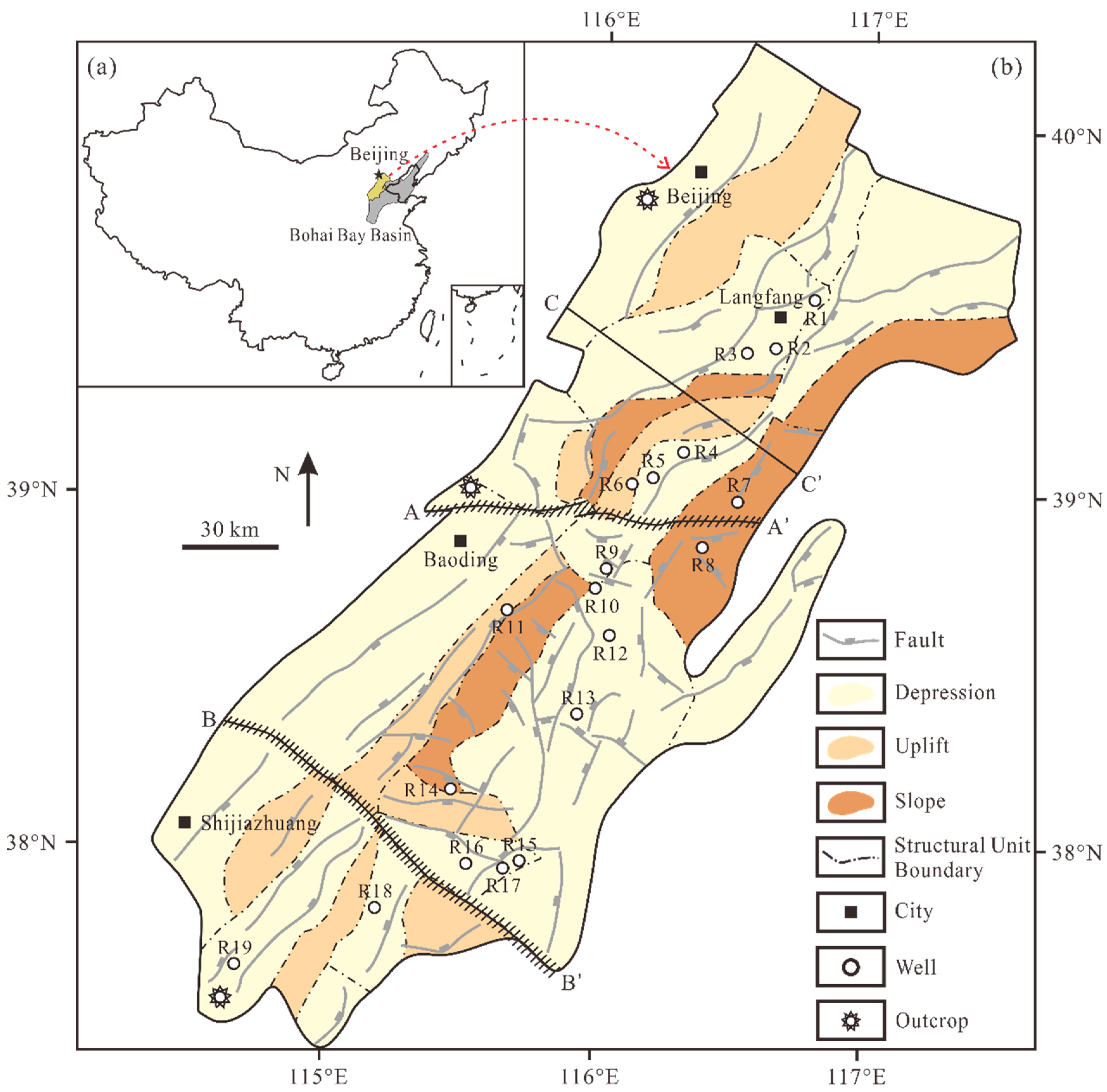
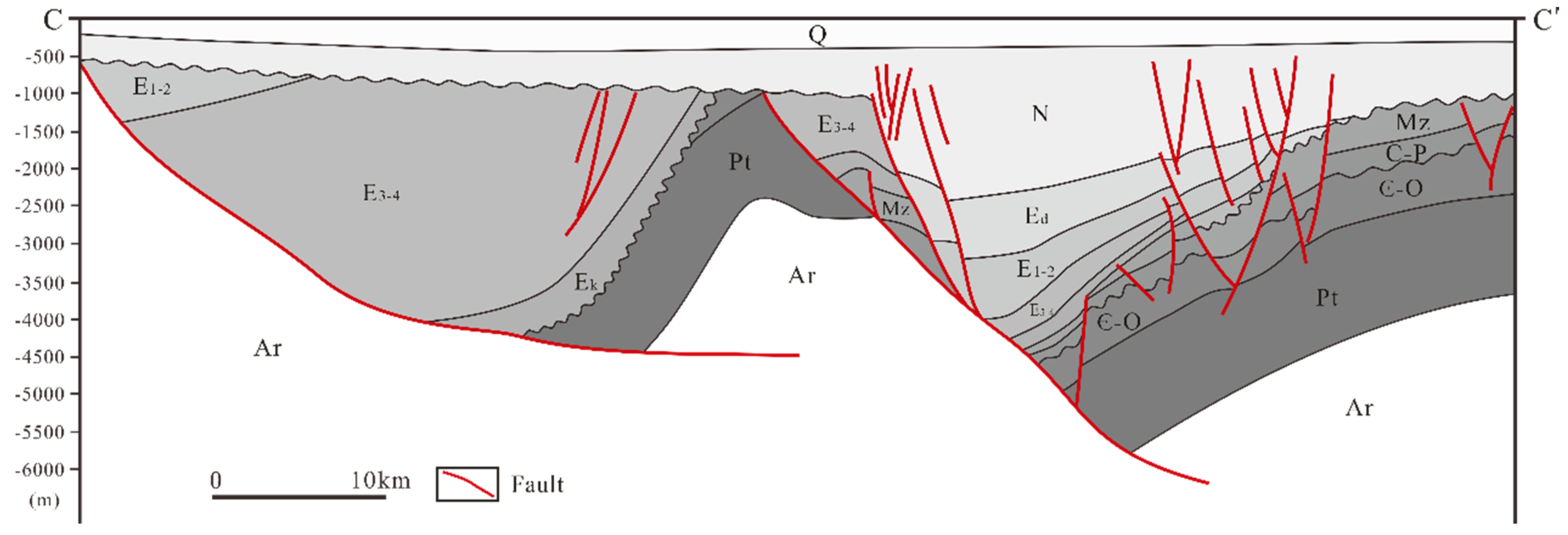
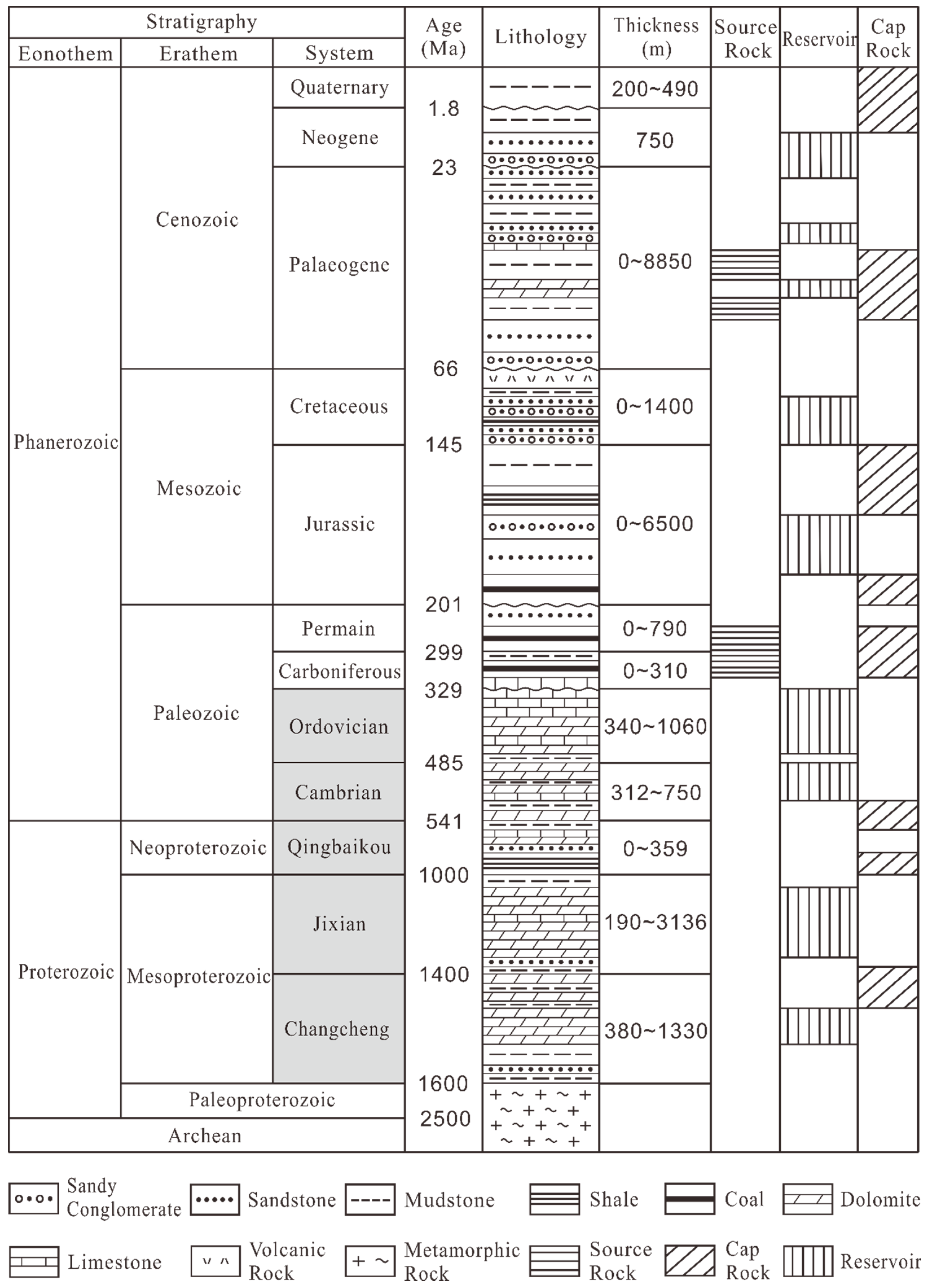

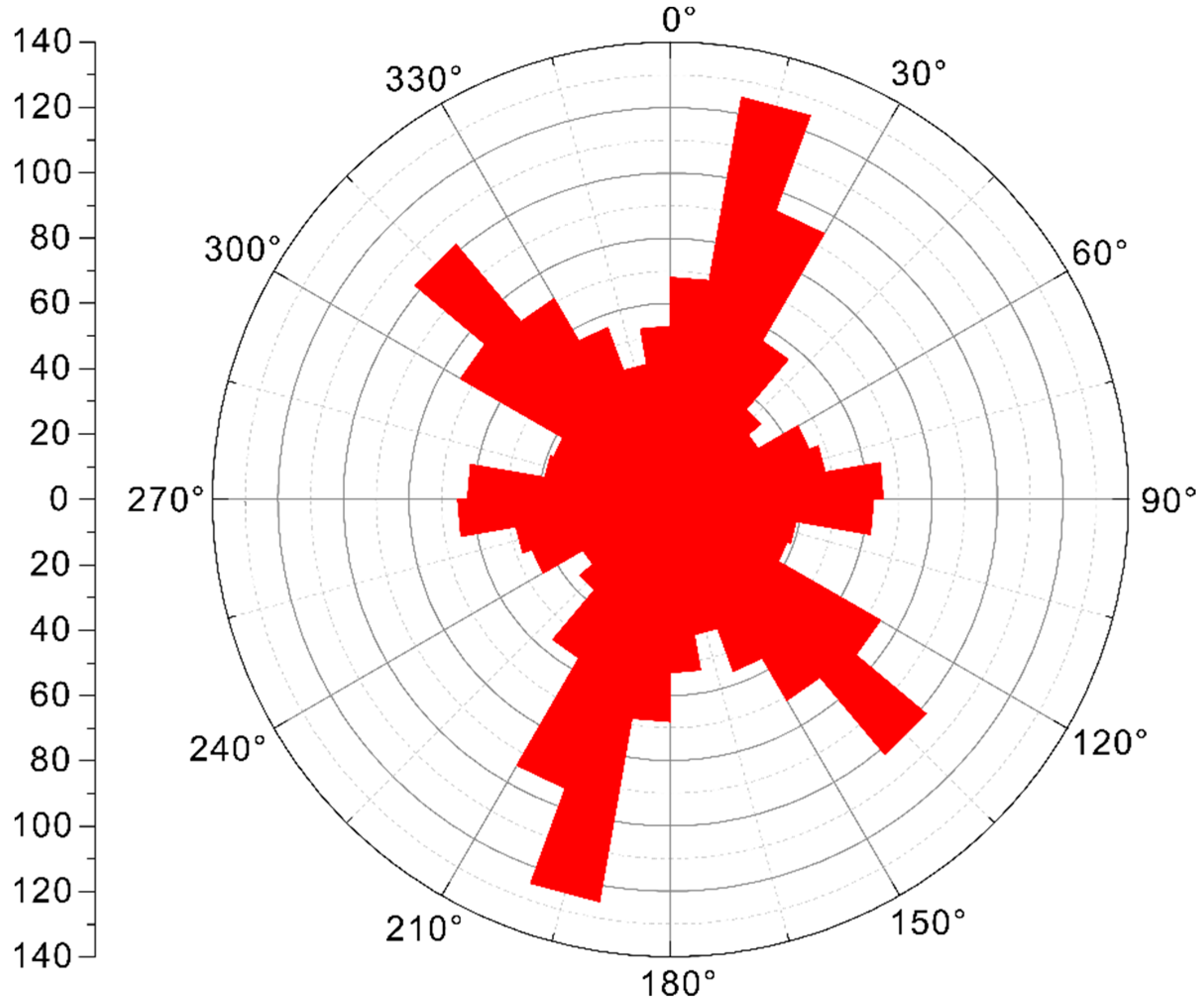
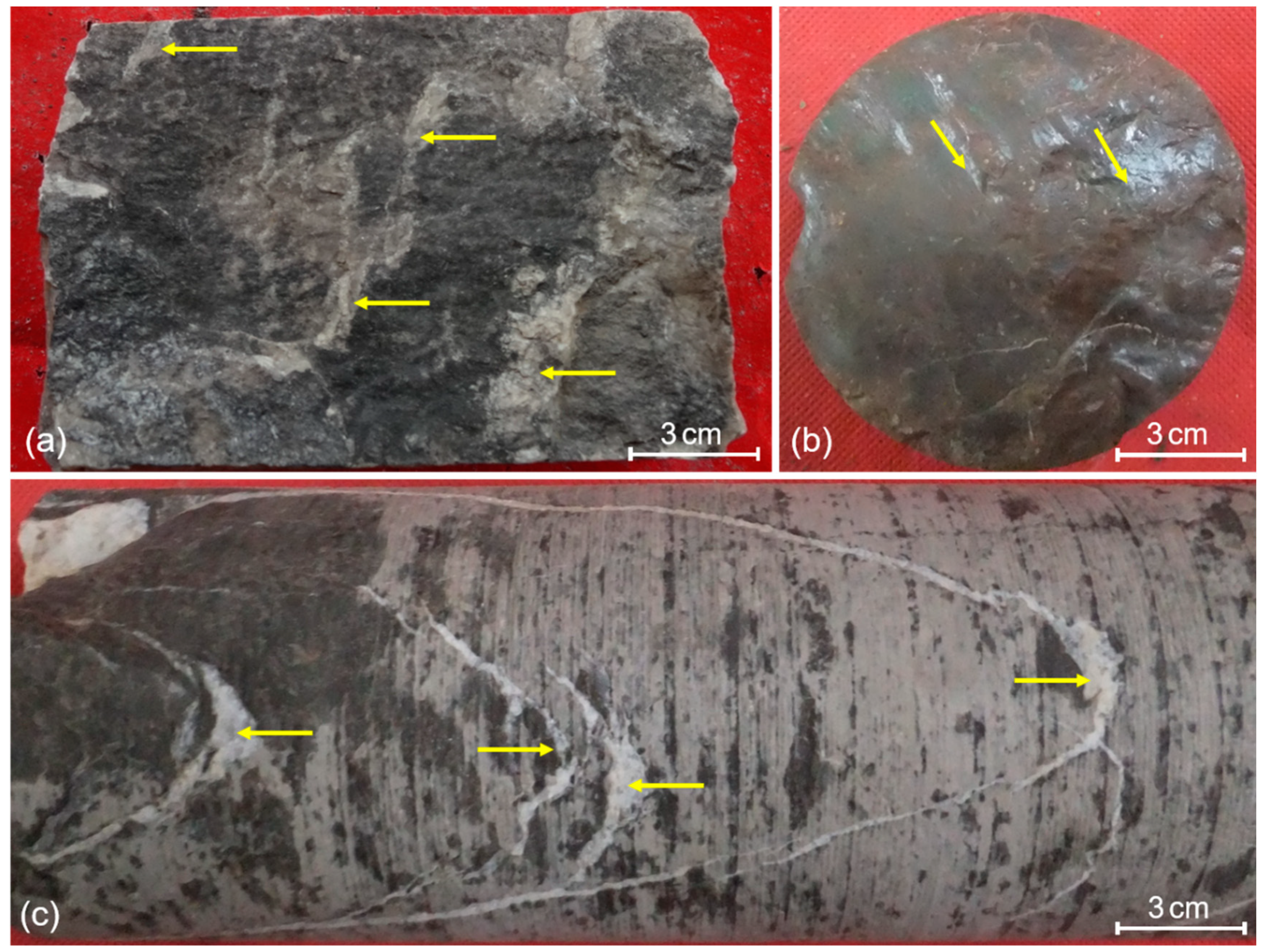



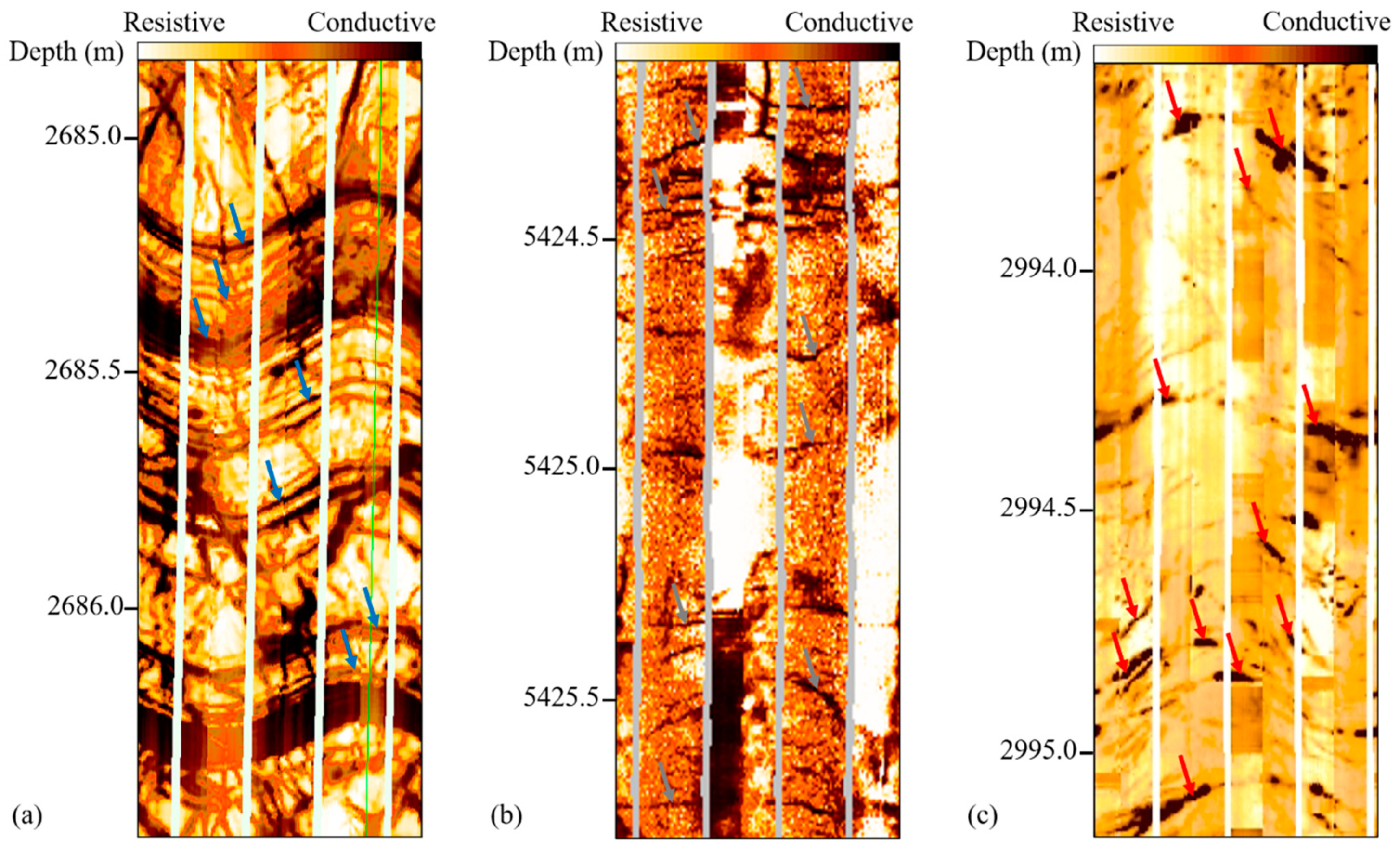
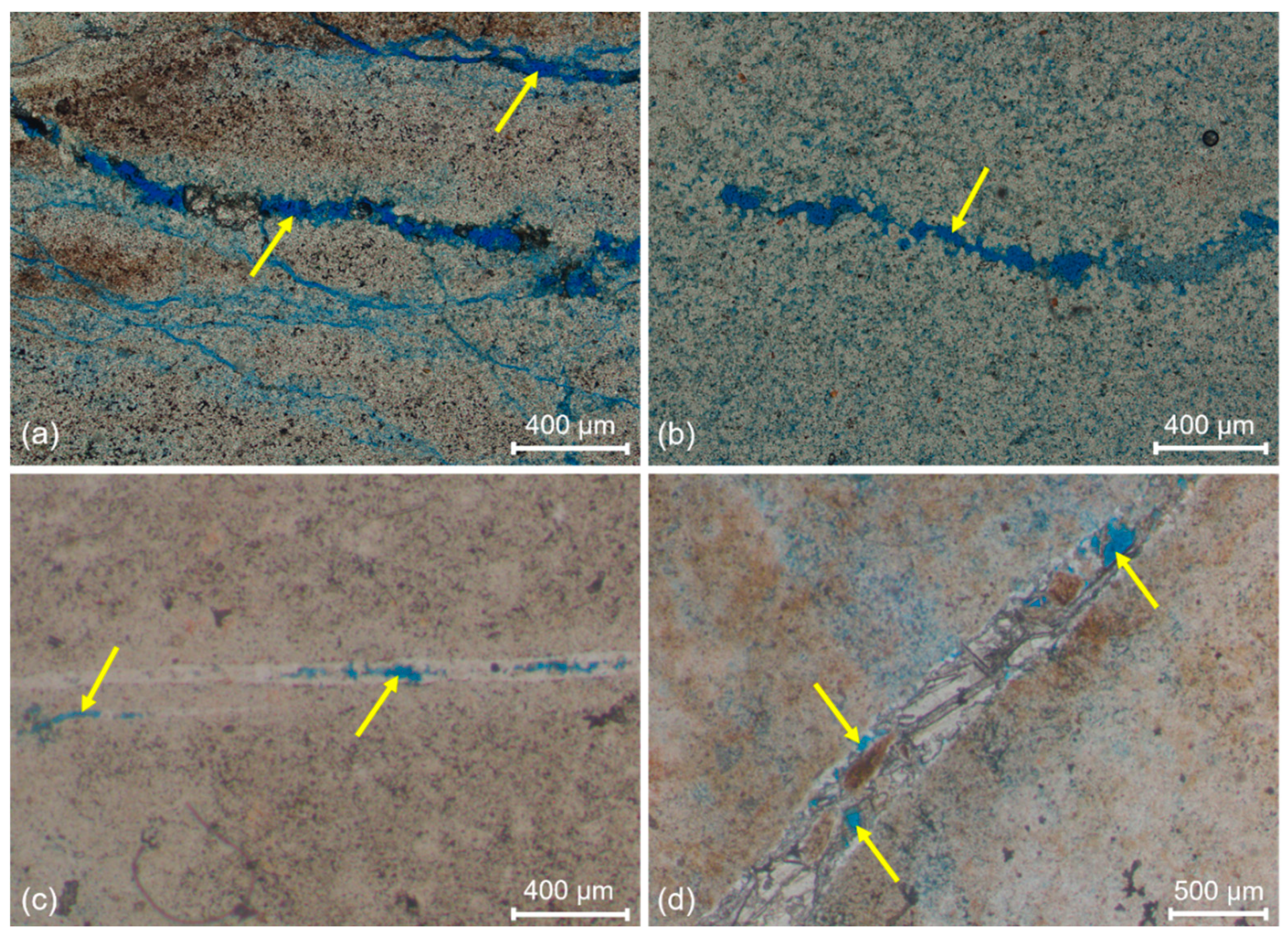


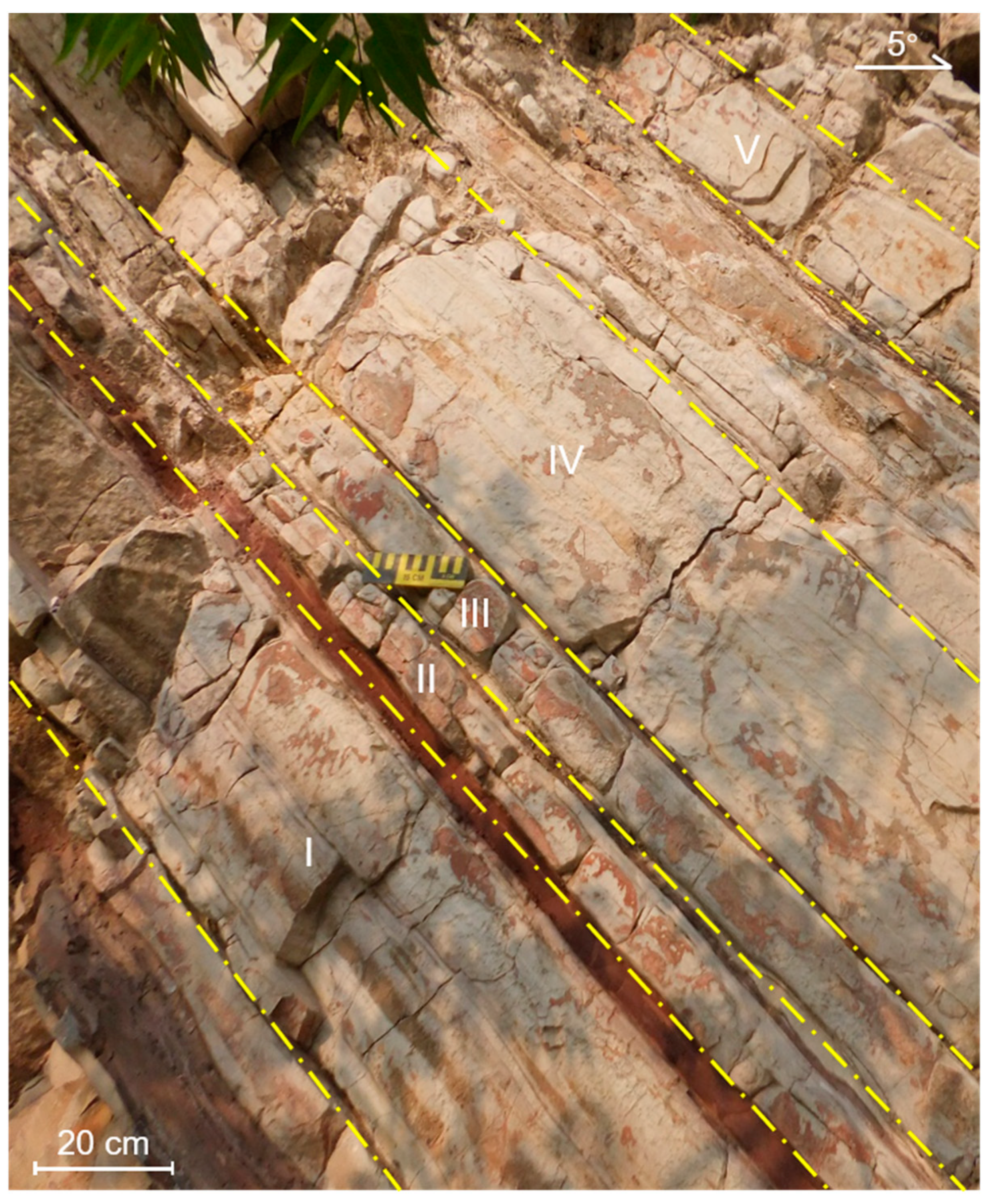

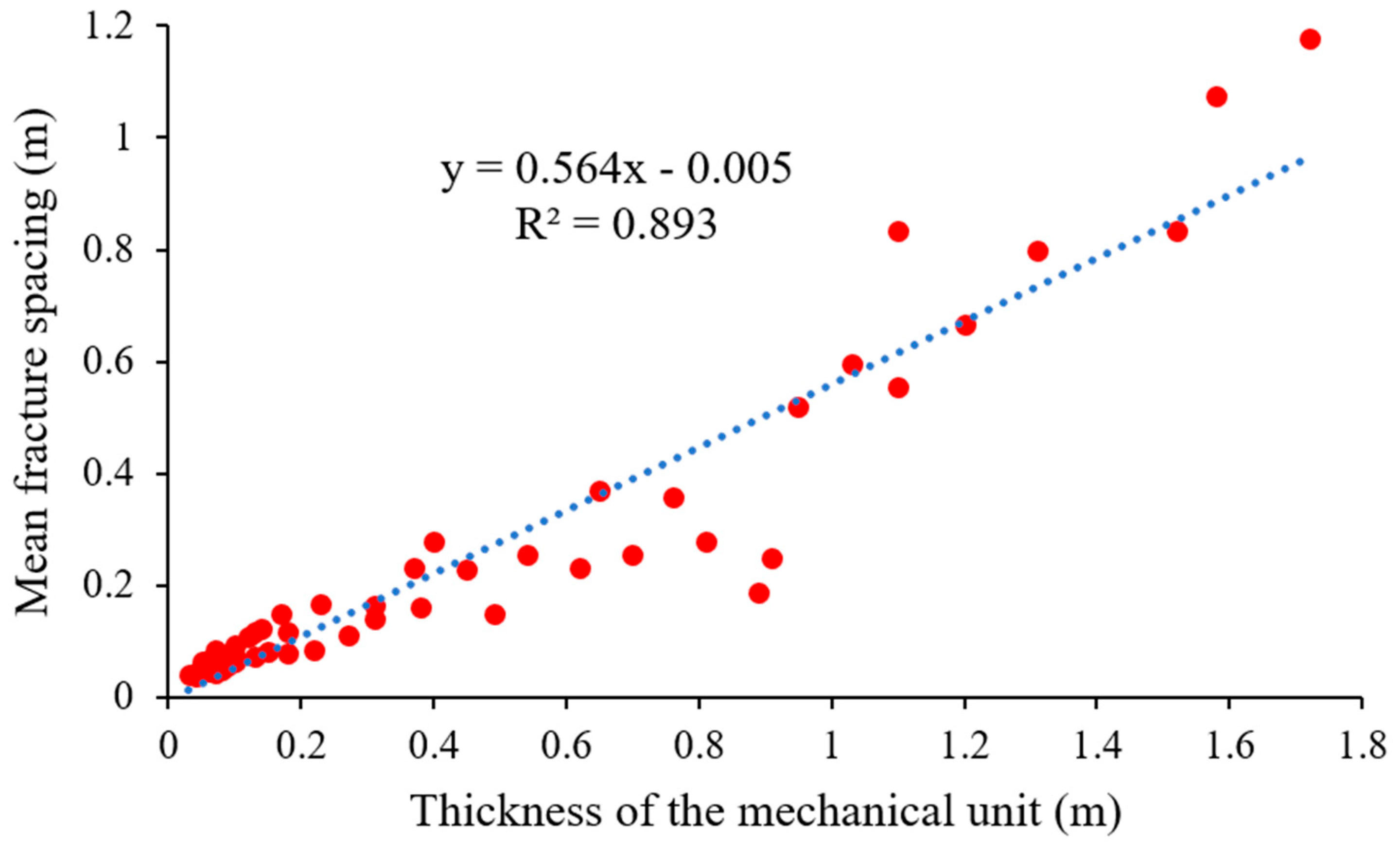
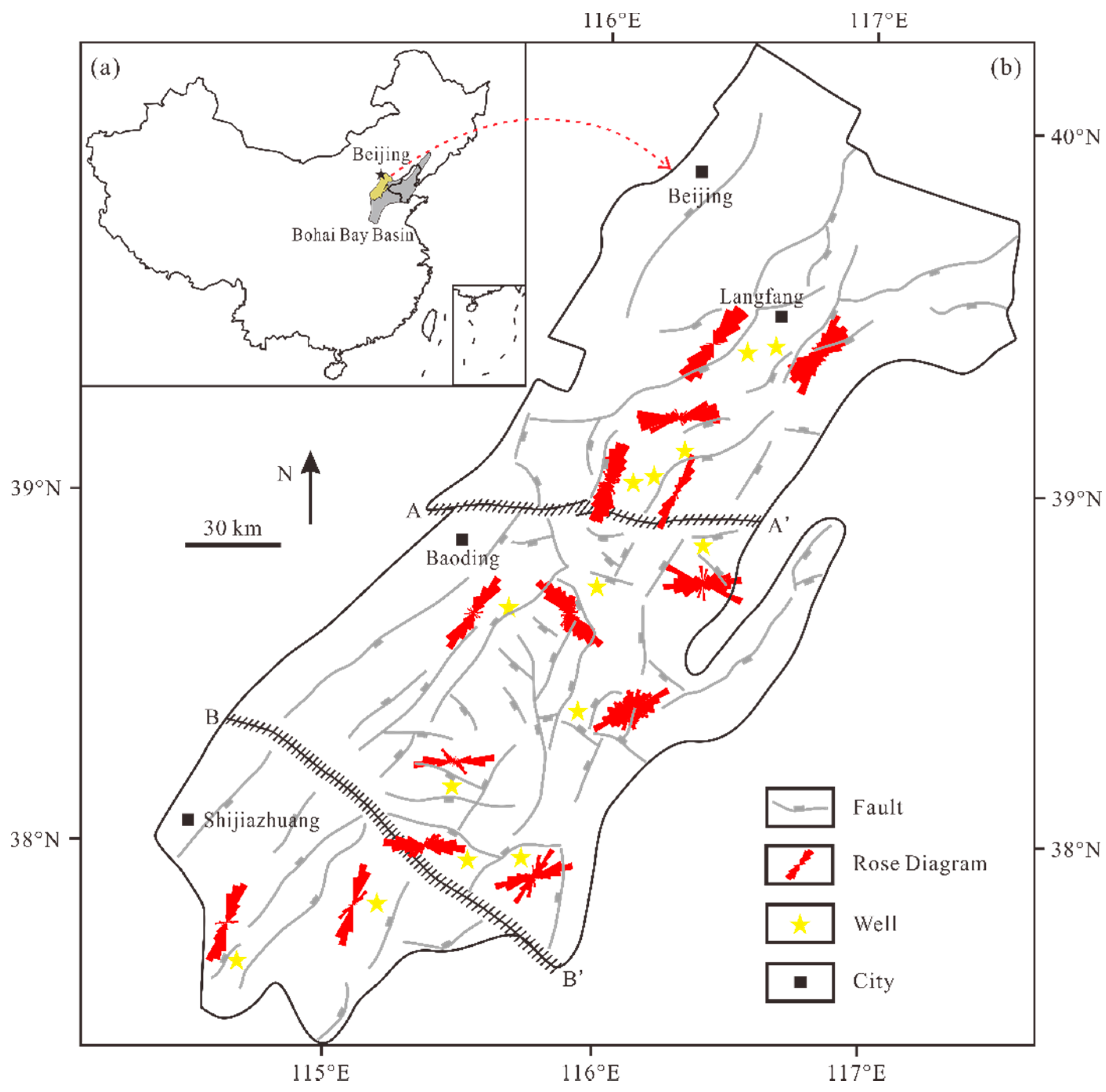


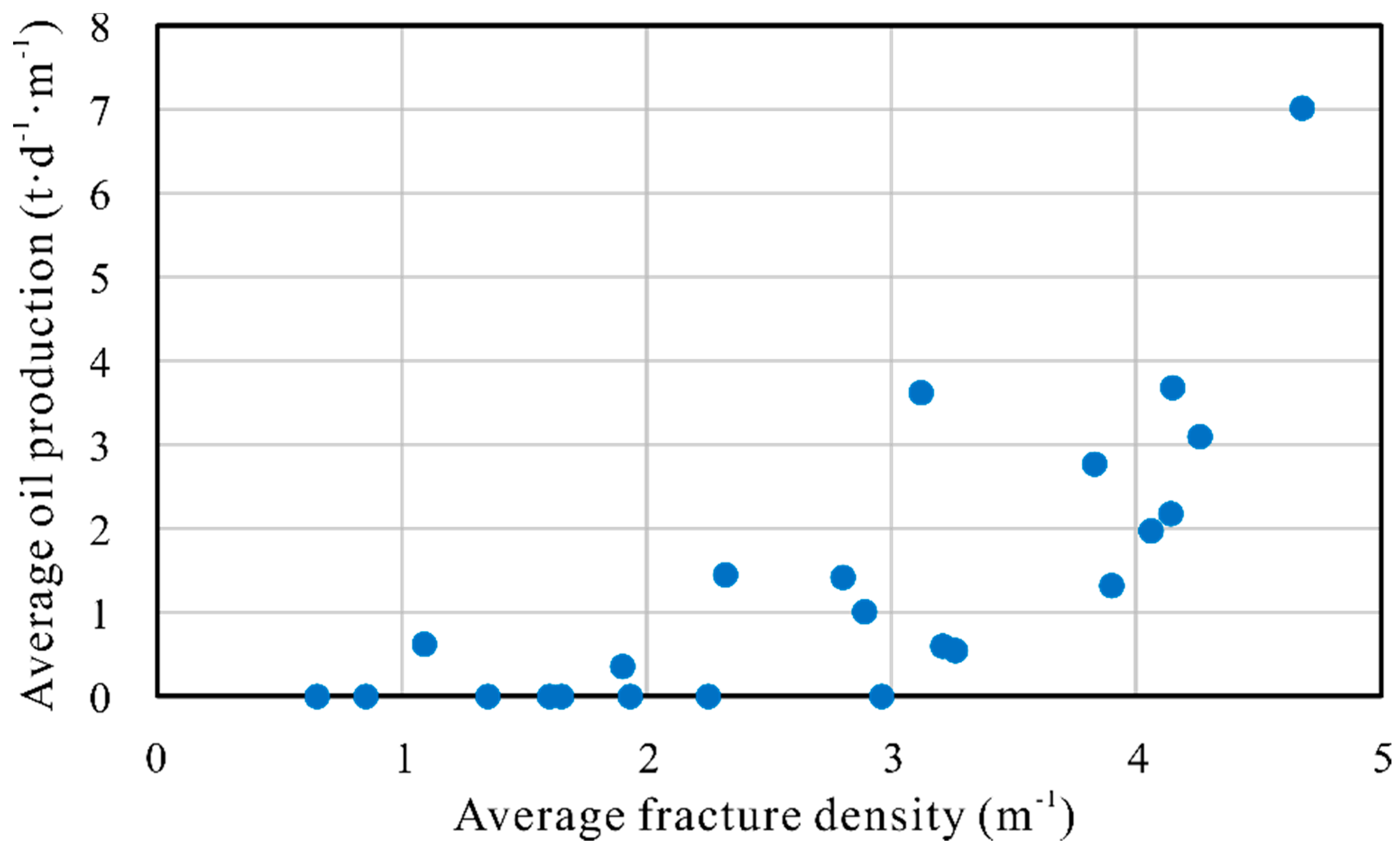
© 2020 by the authors. Licensee MDPI, Basel, Switzerland. This article is an open access article distributed under the terms and conditions of the Creative Commons Attribution (CC BY) license (http://creativecommons.org/licenses/by/4.0/).
Share and Cite
Liu, G.; Zeng, L.; Han, C.; Ostadhassan, M.; Lyu, W.; Wang, Q.; Zhu, J.; Hou, F. Natural Fractures in Carbonate Basement Reservoirs of the Jizhong Sub-Basin, Bohai Bay Basin, China: Key Aspects Favoring Oil Production. Energies 2020, 13, 4635. https://doi.org/10.3390/en13184635
Liu G, Zeng L, Han C, Ostadhassan M, Lyu W, Wang Q, Zhu J, Hou F. Natural Fractures in Carbonate Basement Reservoirs of the Jizhong Sub-Basin, Bohai Bay Basin, China: Key Aspects Favoring Oil Production. Energies. 2020; 13(18):4635. https://doi.org/10.3390/en13184635
Chicago/Turabian StyleLiu, Guoping, Lianbo Zeng, Chunyuan Han, Mehdi Ostadhassan, Wenya Lyu, Qiqi Wang, Jiangwei Zhu, and Fengxiang Hou. 2020. "Natural Fractures in Carbonate Basement Reservoirs of the Jizhong Sub-Basin, Bohai Bay Basin, China: Key Aspects Favoring Oil Production" Energies 13, no. 18: 4635. https://doi.org/10.3390/en13184635




